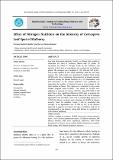Effect of Nitrogen Nutrition on the Intensity of Cercospora Leaf Spot of Mulberry
Publication Date
2021-04-21Author
Type
ArticleMetadata
Show full item record
Abstract/
Leaf spot (Cercospora moricola, Cooke) is a disease that negatively influences the yield of mulberry (Morus alba L.) plants. To determine the effect of nitrogen levels on the incidence and severity of leaf spot an experiment was carried out on mulberry plants. The nitrogen levels included 0, 100, 200 and 300 kg ha-1 ,which were applied in two splits coinciding with the two rainy seasons. The study design was randomized complete block design (RCBD) with three replications. Determination of disease intensity involved scoring for disease intensity on a 1-5 Manandhar scale and calculation of the disease incidence were performed by expressing the number of infected leaves as a percentage of the total number of leaves. The values were translated to area under disease progress stairs (AUDPS). The means for AUDPS were subjected to analysis of variance (ANOVA) using PRO GLM in SAS and Fisher’s least significant difference (LSD) used to partition the means at p≤0.05. The results showed that as the rate of nitrogen application was increased, there was a corresponding decrease in AUDPS for disease incidence and a decrease in AUDPS for disease severity. From the obtained results it can be concluded that nitrogen at an application rate of 200 kg ha-1 is an effective approach to suppress Cercospora leaf spot of mulberry and can be recommended to the farmers, where this disease is a problem for cultivation of mulberry.
